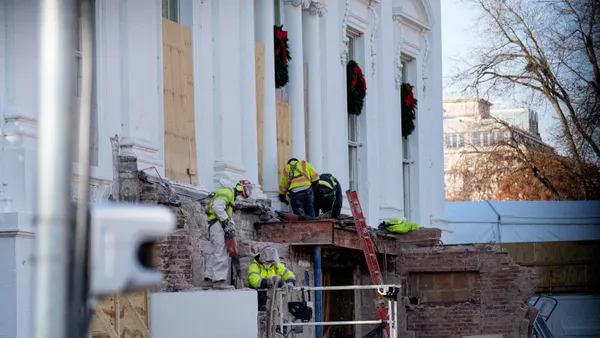Dive Brief:
-
Six more contractors and designers have settled lawsuits for undisclosed amounts with victims' families and the survivors of the March 15, 2018, pedestrian bridge collapse at Florida International University (FIU) in Miami, the Miami Herald reported.
-
Among the companies that settled is FIGG Bridge Group, which designed the pedestrian span. The other five companies are Bolton Perez & Associates; Corradino Group; A&P Consulting Transportation Engineers Corp.; RLT Engineering Services LLC; and Gerdau Ameristeel US Inc. There are more than 20 defendants being sued in civil lawsuits in Miami-Dade Circuit Court for their alleged roles in the collapse.
-
The attorney who announced the deal represents the family of one of those killed in the collapse and said this latest development could lead other defendants to settle as well.
Dive Insight:
The money won through this latest settlement will be added to the pool of $42 million that was set aside during bankruptcy proceedings initiated by the general contractor for the FIU project — Magnum Construction Management (MCM), which went by Munilla Construction Management at the time of the collapse.
The Miami-based construction company filed for Chapter 11 bankruptcy on March 1, 2019, and said it lost $200 million of potential income from future contracts, as well as its Florida DOT certifications after the accident. The company said that it is continuing operations despite the bankruptcy.
While the fight continues around a resolution to civil court financial claims, reports since the collapse have pointed the finger of blame at FIGG and other contractors.
The last of the National Transportation Safety Board's interim reports, issued in August 2018, said that their testing found no problems with the material, which left design and installation as potential contributing factors. The bridge was manufactured offsite and then brought onto the FIU campus for installation.
OSHA has also weighed in on the collapse, pulling no punches in identifying where FIGG, MCM and other designers and contractors went wrong. In a report issued last month, the agency said the cracks that appeared in the bridge's structure before the collapse were a sign of errors in FIGG's design. OSHA said the bridge should have been shored up, work stopped and traffic underneath the span shut down until corrective steps could be taken to ensure the structure's integrity.
The method of building the FIU span, known as Accelerated Bridge Construction, was put under a microscope after the collapse, but the method continues to help transportation agencies build and replace bridges on a tighter schedule with increased safety for both tradesmen, who don't have to work at higher reaches and instead can do their work in a near-factory setting, and motorists, who don't have to navigate construction zones and alternate routes for extended periods of time.
For instance, the Connecticut DOT recently shaved an estimated two years off of the construction schedule for the replacement of a bridge over Interstate 95 in Stamford, Connecticut. After manufacturing the bridge offsite, contractor O&G Industries was able to install it during just two weekends.













